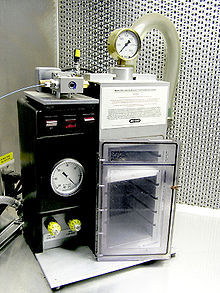
In genetic engineering, a gene gun or biolistic particle delivery system is a device used to deliver exogenous DNA (transgenes), RNA, or protein to cells. By coating particles of a heavy metal with a gene of interest and firing these micro-projectiles into cells using mechanical force, an integration of desired genetic information can be introduced into desired cells. The technique involved with such micro-projectile delivery of DNA is often referred to as biolistics, short for "biological ballistics".[1][2]
This device is able to transform almost any type of cell and is not limited to the transformation of the nucleus; it can also transform organelles, including plastids and mitochondria.[3]

- The gene gun apparatus is ready to fire.
- Helium fills the chamber and pressure builds against the rupture disk.
- The pressure eventually reaches the point where the rupture disk breaks, and the resulting burst of helium propels the DNA/gold-coated macrocarrier ('Plastic Disk') into the stopping screen.
- When the macrocarrier hits the stopping screen, the DNA-coated gold particles are propelled through the screen and into the target cells.
- ^ O'Brien, John A.; Lummis, Sarah CR (2011). "Nano-biolistics: A method of biolistic transfection of cells and tissues using a gene gun with novel nanometer-sized projectiles". BMC Biotechnology. 11: 66. doi:10.1186/1472-6750-11-66. PMC 3144454. PMID 21663596.
- ^ Carter, Matt; Shieh, Jennifer (6 March 2015). "Chapter 11 - Gene Delivery Strategies". Academic Press (Second ed.). ISBN 978-0-12-800511-8.
- ^ Sanford, John C. (1990). "Biolistic plant transformation". Physiologia Plantarum. 79 (1): 206–209. doi:10.1111/j.1399-3054.1990.tb05888.x. ISSN 1399-3054.